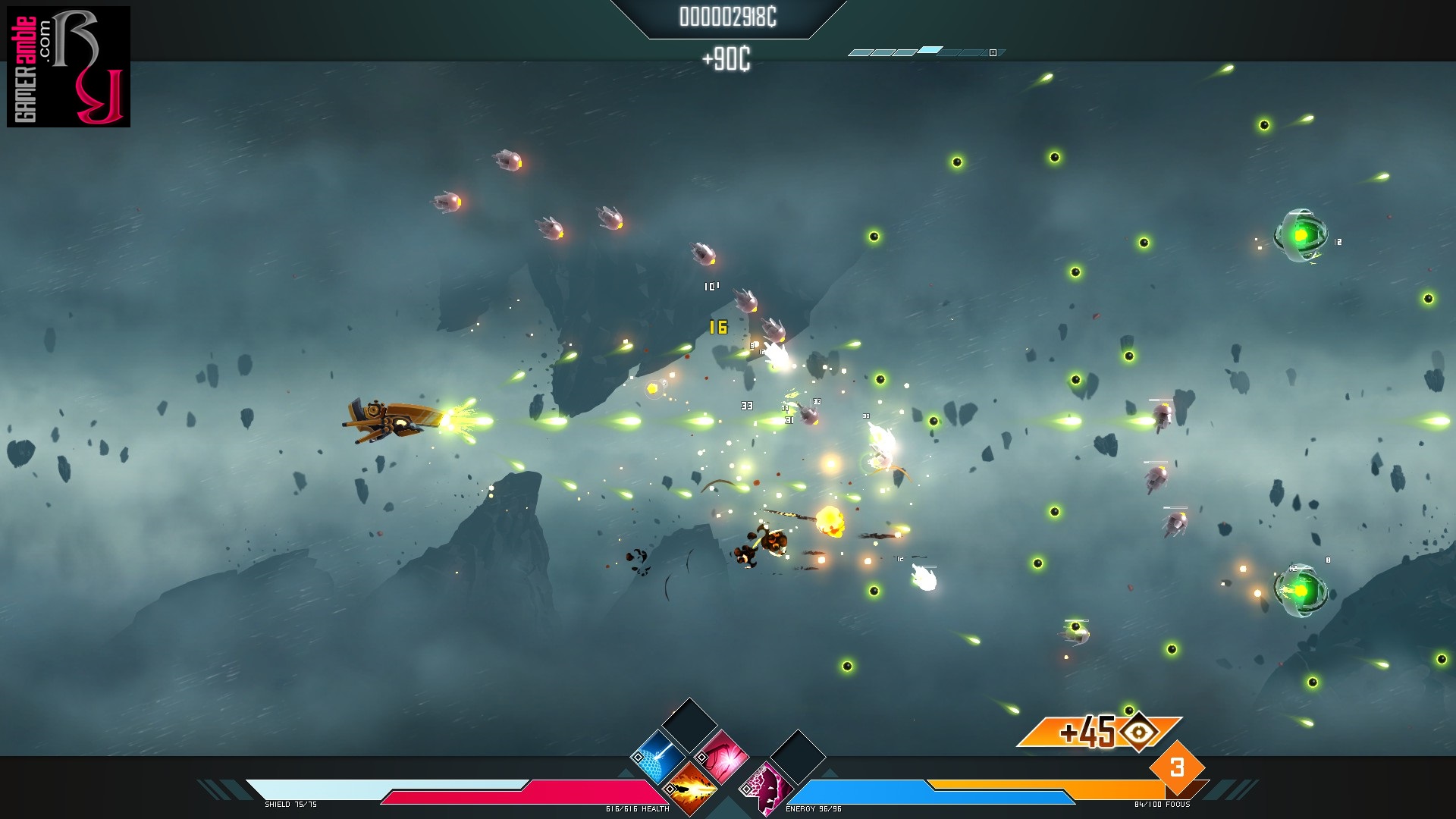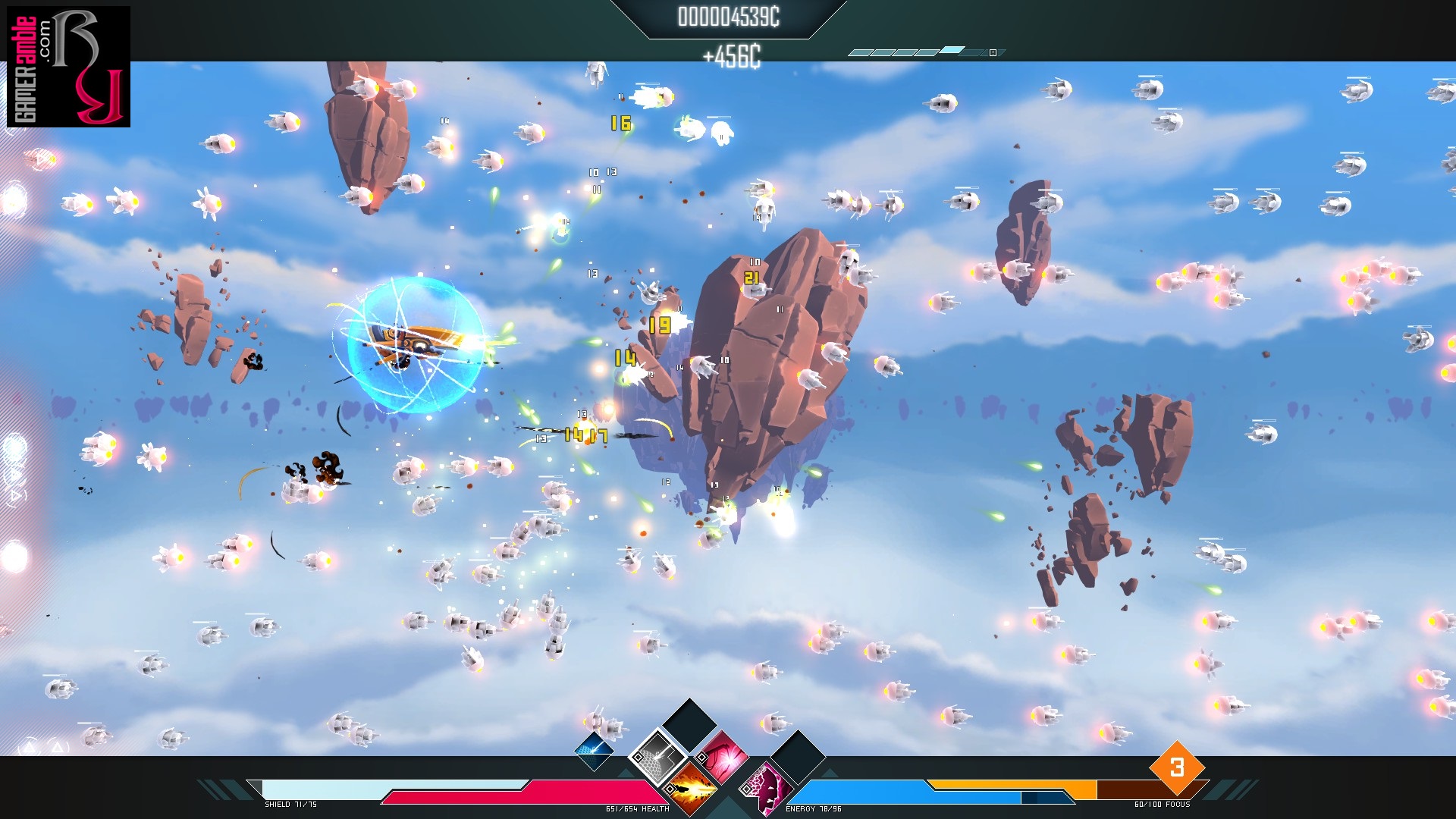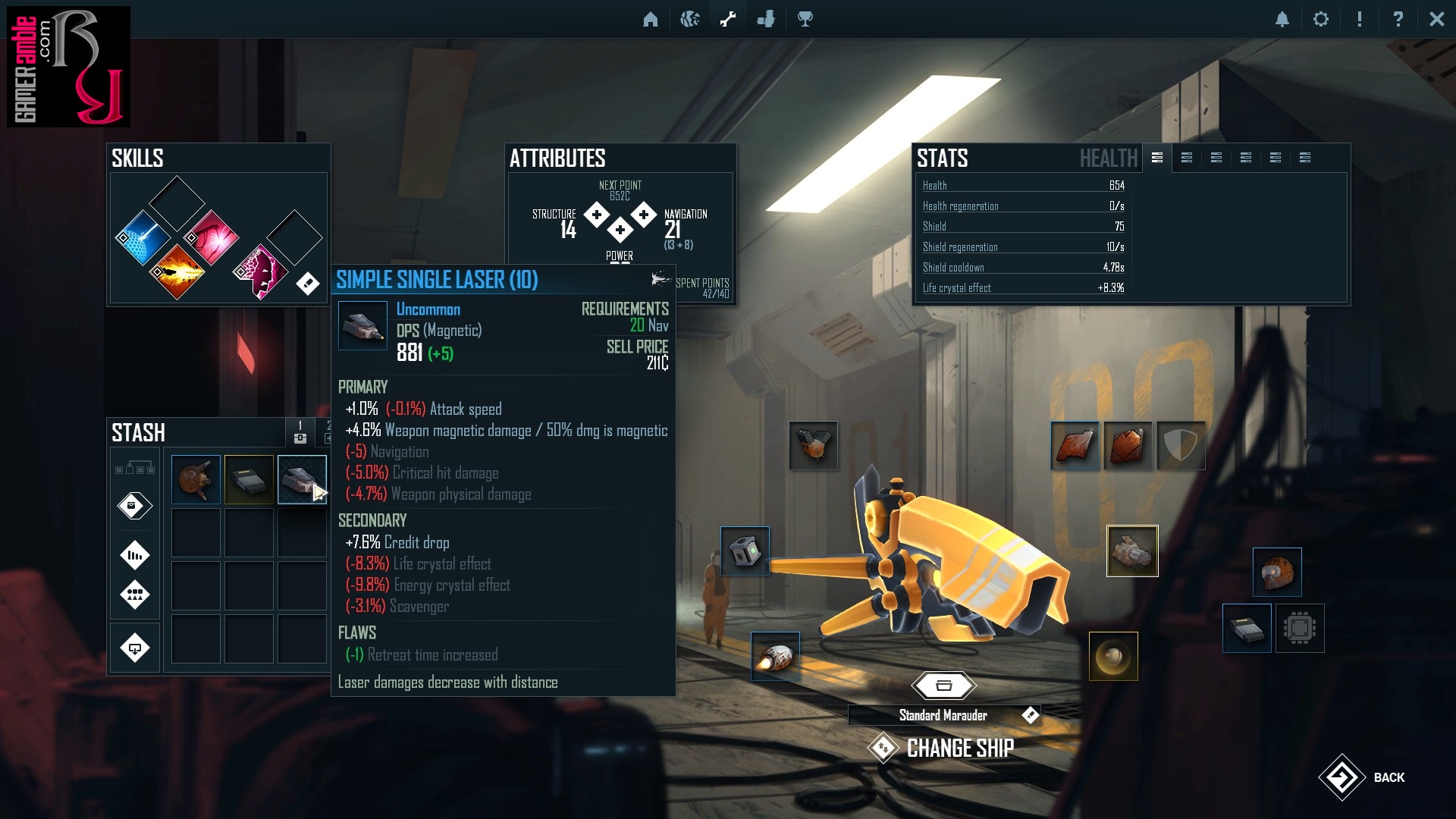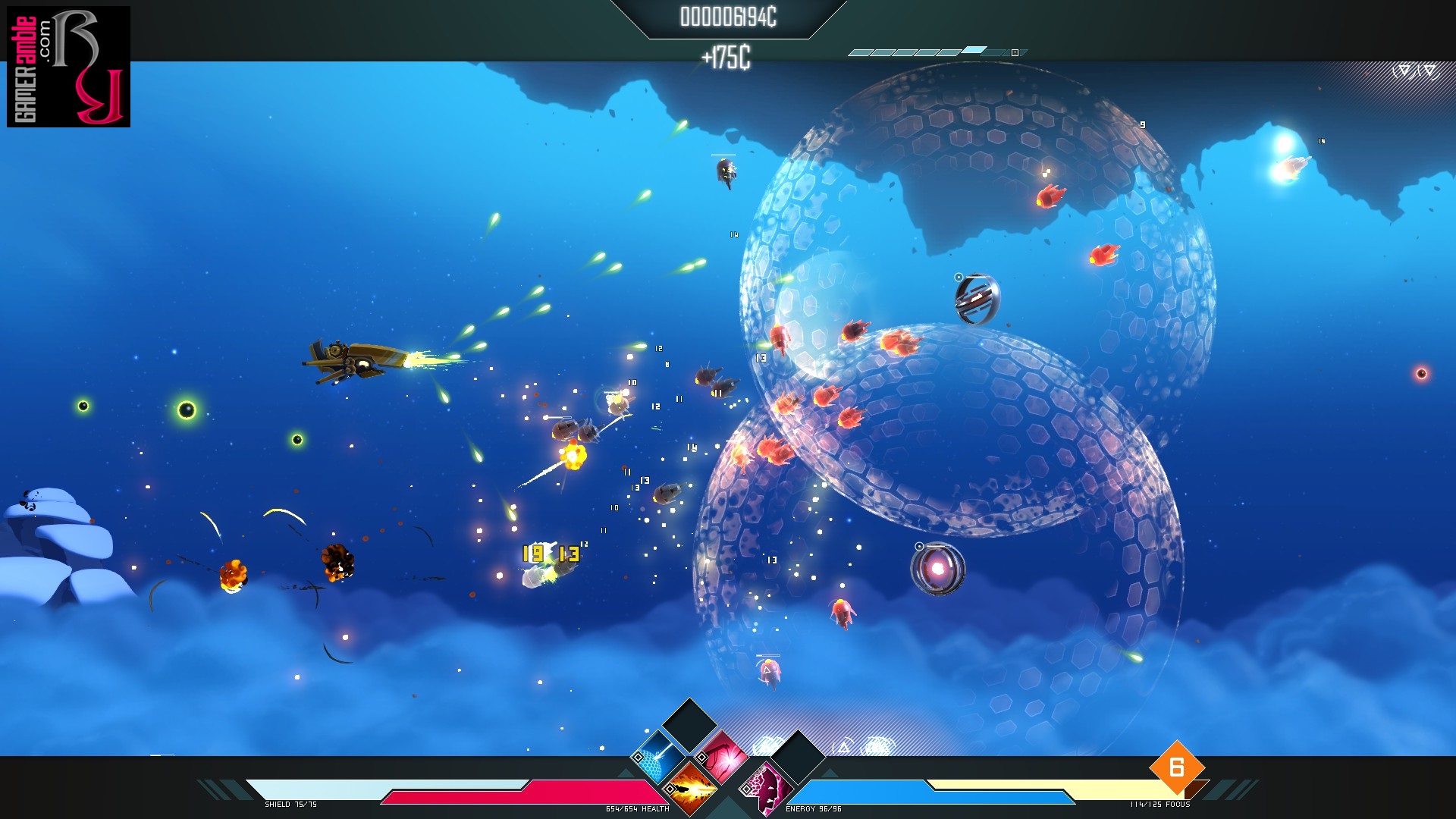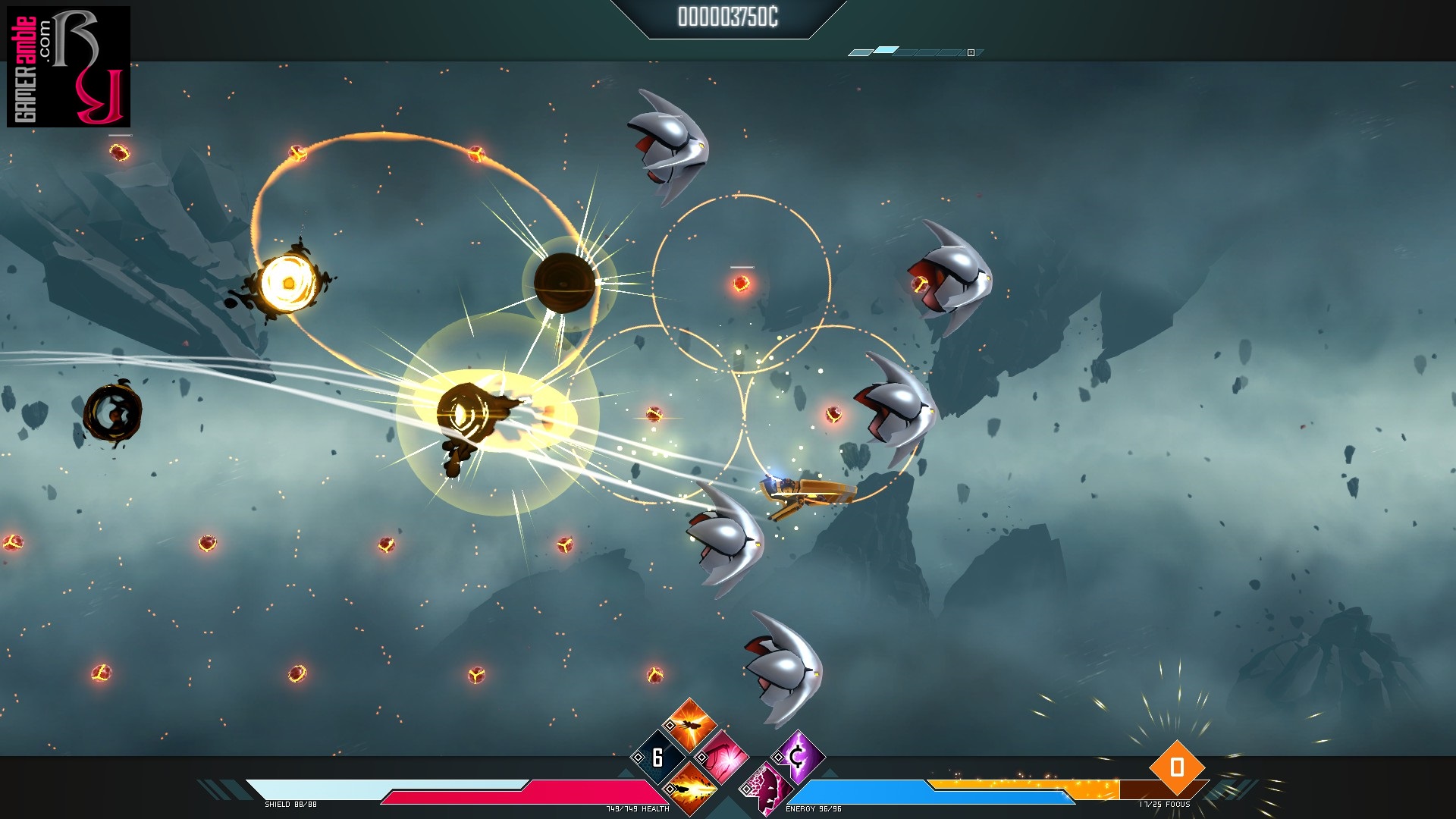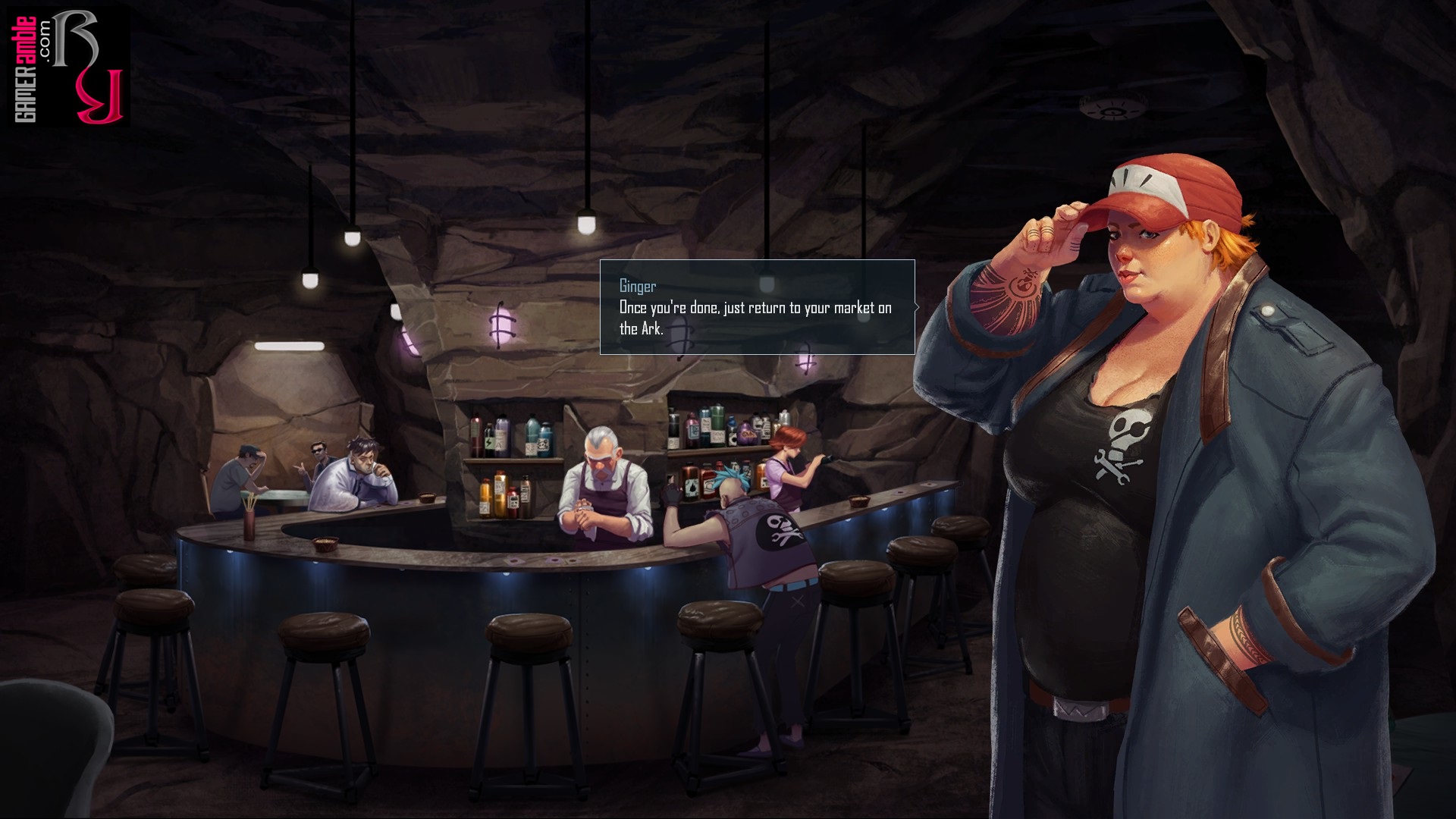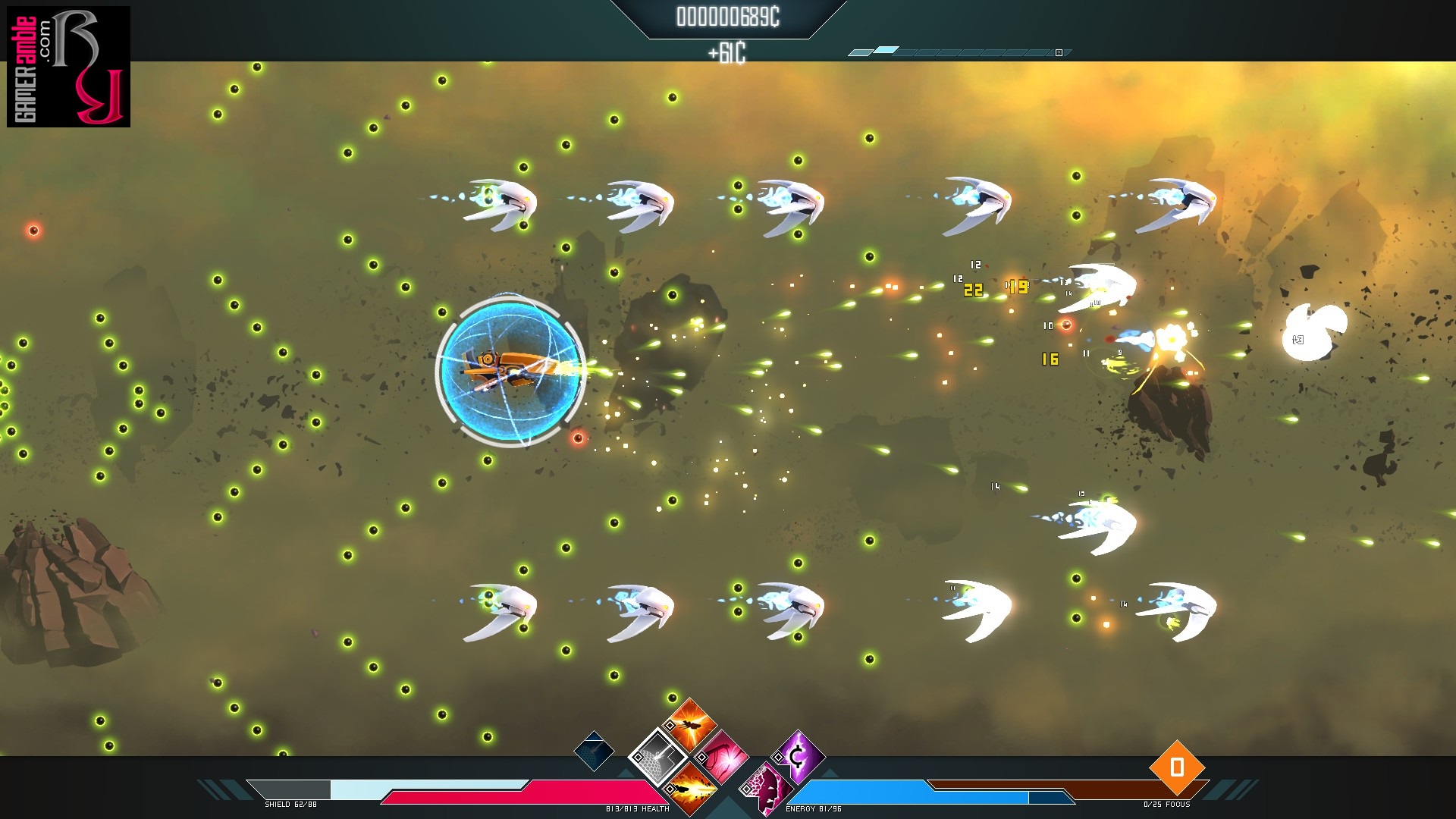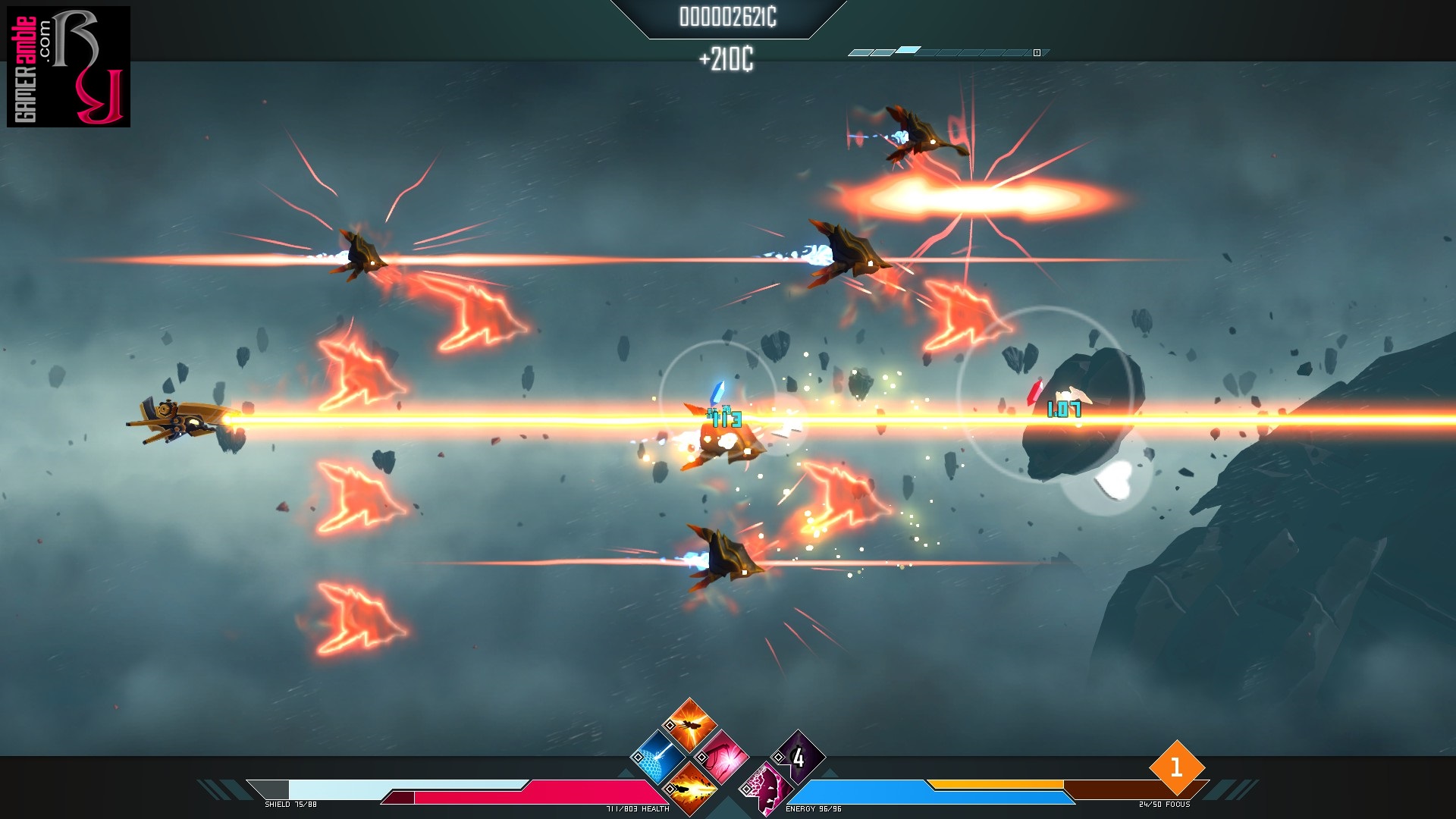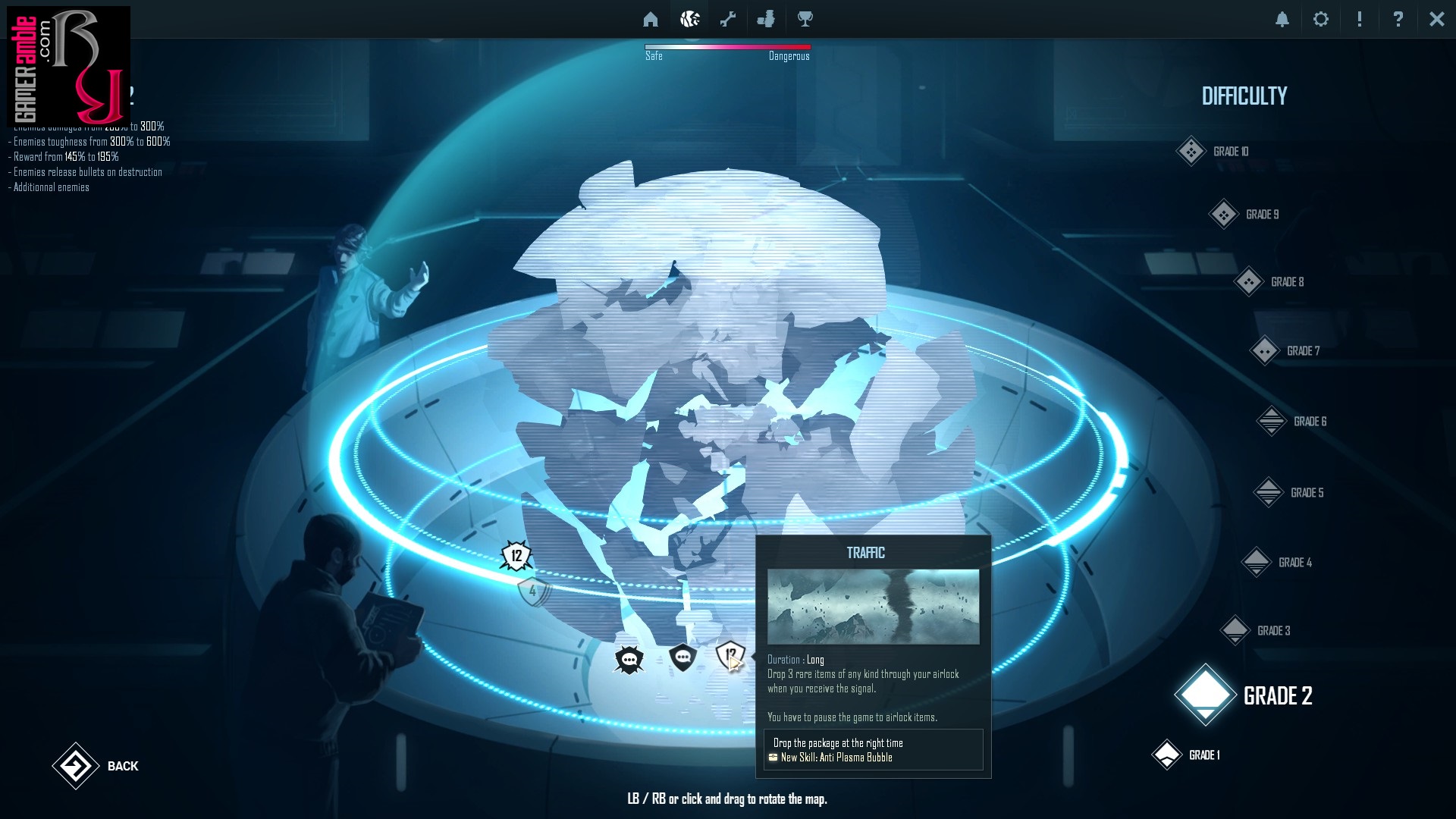Drifting Lands
Developer: Alkemi | Publisher: Alkemi | Release Date: 2017 | Genre: Action / Indie / RPG / Shoot ‘Em Up | Website: Official Website | Purchase: Steam
As enjoyable as the side-scrolling shooter genre is, there is no doubt that many entries suffer from either being too short, too difficult, or both. This is why Drifting Lands is a breath of fresh air for anyone who has ever tried to play something from this genre, only to get blown to smithereens in the first few minutes. That’s not to say it is an easy game, as the difficulty does ramp up nicely, but it is certainly more accessible. What sets Drifting Lands apart from the competition, though, is how it has fused its horizontal shooting action with some action RPG elements. Think of it as Diablo in a spaceship, and you won’t be far off.
As the title suggests, Drifting Lands is set in a world where the planet has shattered and is now just a collection of rocks floating in space. While billions died in this catastrophe, there were also plenty of survivors, including the pilots, engineers, and traders who live aboard a massive ship called the Ark. As the game opens, you are the newest citizen of the Ark and must prove that you deserve a spot on-board by flying missions against its enemies. These foes range from robots to corporations and crazy cults, so you have your work cut out for you. It’s not really the most epic of storylines, but it is a step up from the usual alien invasion fluff and also introduces you to plenty of unique characters. However, the storyline is not the game’s primary focus and only serves as an excuse to take to the skies and blast as many enemies as possible into chunks of loot.
Drifting Lands presents players with three different ship classes to choose from, ranging from fast and deadly to slow but sturdy and something in the middle. This means that players experienced with the genre can jump right in with a nimble ship that can dish out the pain but take very little in return, while rookies can ease into things with something a little more durable. In addition, all of the ships have shields and health, so even the weakest class won’t just disintegrate at the first sign of trouble. Throw in the handy tutorial, which explains some of the finer details of playing Drifting Lands, and you have a shooter that is undoubtedly more newcomer-friendly than most. However, with 100 levels of difficulty, randomly generated missions, and an extensive ship upgrade system, sooner or later, you will begin to encounter the type of heavy resistance that requires you to sit up and pay attention.
The upgrade system, in particular, can be a little daunting initially for anyone unfamiliar with grinding for the best loot. Any loot picked up during battle is stored in your cargo hold until the mission is completed, at which point, you can unload what you found, compare it to what you have, and swap out where needed before selling the rest for credits. Every single piece of loot you collect, be it weapons, shields, armor, thrusters, and more, all have a range of primary and secondary modifiers to take into consideration. So, for example, the damage per second stats for a weapon is important, but you also need to look at what other attributes it influences and even if it has “flaws” that can cause issues.
It sounds rather complicated and can be a nuisance if you simply want to get out there and fly, but it does enable you to micromanage every aspect of your ship. Everything from health and shield regeneration to energy, critical hit chances, attack speed, credit earning ability, and pick-up radius can be tweaked with your loadouts. Anyone who has spent hours shaping their RPG character will know how addictive this process can be.
In addition to your loadout, you can spend your hard-earned credits increasing the structure, navigation, and power attributes of your chosen craft. These attributes determine what loads you can equip, so don’t forget about them. If this wasn’t enough, you also eventually have access to 70 different skills from which you must choose four active and two passive ones. These skills are as varied as they are helpful and can drastically influence your playing style. Defensive players can opt for a self-powered bubble to absorb bullets, while those preferring a more aggressive approach can opt for area-of-effect attacks. Perhaps mines are more your forte or slowing down time. All these skills are divided into different categories and additional options are unlocked by moving up the grades, which keeps things fresh. Since most skills must be activated manually and have cool-down periods, they are a little trickier than the usual power-ups found in shooters. Still, it is also a lot more satisfying to pull them off efficiently. We definitely recommend that newcomers stick with the “Automatic Retreat” skill, though, as without it, you are basically playing in hardcore mode.
Speaking of the “grade” system, it is used to determine the game’s difficulty. There are a total of ten grades, and each one increases the damage enemies can inflict, how much punishment they can take, how many of them you have to deal with, and even additional factors, such as whether they release bullets on destruction. Higher grades also mean more rewards and access to better variants of ships to purchase, so it’s not all doom and gloom either. Don’t worry if ten grades sound like too much either, as the story pretty much ends by grade 4, so everything above it is optional.
Visually, Drifting Lands sports a pretty unique look for a shooter. The art style is very detailed, and you get to fly past many varied backgrounds. Some levels also throw some nifty-looking weather effects at you, which looks really nice. The screen can get a little cluttered at times, thanks to the sheer amount of bullets and explosions going on, but this is about par for the genre. Your enemies are also varied, although combat is strictly air-to-air, and you’ll never see any ground-based targets. Foes can, however, attack from any corner of the screen and even fly out of the foreground or background to catch you by surprise. The only downside is that eventually, you’ll have seen most of the backgrounds on offer, and repetition will begin to set in. The vast number of levels and procedural style of the game also means that it doesn’t really have any standout moments or levels like in more scripted shooters. Story scenes play out via largely static cutscenes but feature some very nice hand-painted designs.
The soundtrack of Drifting Lands was an unexpected highlight, and all of the tunes blasting through your speakers are good enough to warrant a purchase of the soundtrack edition. Our favorites are the ones with rocking guitar sounds, but other genres are also featured and are equally good. Sound effects, on the other hand, are decent, if a bit underwhelming, but at least they don’t drown out the music. The developers did revamp the weapon sound effects in a later update to make them stronger and louder. Despite plenty of story-based cutscenes, the game lacks speech, so you’ll have to read all the conversations. The developers recommend playing the game with a controller, and we have to agree that it definitely makes it easier to maneuver and activate the myriad of skills. On the other hand, the user interface for the Ark sections, where you choose missions, upgrade your ship, or sell items, definitely works better with a mouse. A post-release patch for the game added the option to use mouse control during gameplay phases and a slow movement mode for more precision.
As much fun as Drifting Lands is to play, it is also a title that will probably divide opinions. Some players will find the endless cycle of finding new loot and customizing their ship a lot of fun, while for others, the tedium could set in quickly. Like any action RPG, there is a certain amount of grind involved, which is not something that is usually associated with making progress in a side-scrolling shooter. However, it would be hard to criticize Drifting Lands for becoming repetitive after hours of playing when most other titles in the genre are content with offering five levels that can be blasted through in under an hour. Thankfully, a demo for Drifting Lands is available on Steam, so if you are unsure whether its blend of shooting and looting will appeal to you, we recommend trying it out first.
System Requirements
- Minimum PC System Requirements
- Recommended PC System Requirements
- Minimum Mac OS X System Requirements
- Recommended Mac OS X System Requirements
- OS: Windows XP or Better
- Processor: Anything for gaming bought in the past 2 or 3 years
- Memory: 2 GB RAM
- Graphics: Any AMD/ATI or NVidia with more than 512Mo of DEDICATED RAM
- DirectX: Version 9.0c
- Storage: 1 GB available space
- Sound Card: Anything that goes beyond bleep really
- Additional Notes: Will most probably not work with Intel video cards
- OS: Windows 7 or 8
- Processor: Intel Quad Processor
- Memory: 4 GB RAM
- Graphics: Any powerful AMD/ATI or NVIDIA card with more than 512 of RAM
- DirectX: Version 9.0c
- Network: Broadband Internet connection
- Storage: 1 GB available space
- Sound Card: Anything that goes beyond bleep really
- Additional Notes: More fun with a pad though you can use your keyboard
- OS: Snow Leopard
- Processor: Anything for gaming bought in the past 2 or 3 years
- Memory: 2 GB RAM
- Graphics: Any AMD/ATI or NVidia with more than 512Mo of DEDICATED RAM
- Storage: 1 GB available space
- Sound Card: Anything that goes beyond bleep really
- Additional Notes: In a test phase on Mac
- OS: Mavericks or more recent
- Processor: Quad Processor
- Memory: 4 GB RAM
- Graphics: Any powerful AMD/ATI or NVIDIA card with more than 512 of RAM
- Network: Broadband Internet connection
- Storage: 1 GB available space
- Sound Card: Anything that goes beyond bleep really
- Additional Notes: In a test phase on Mac



